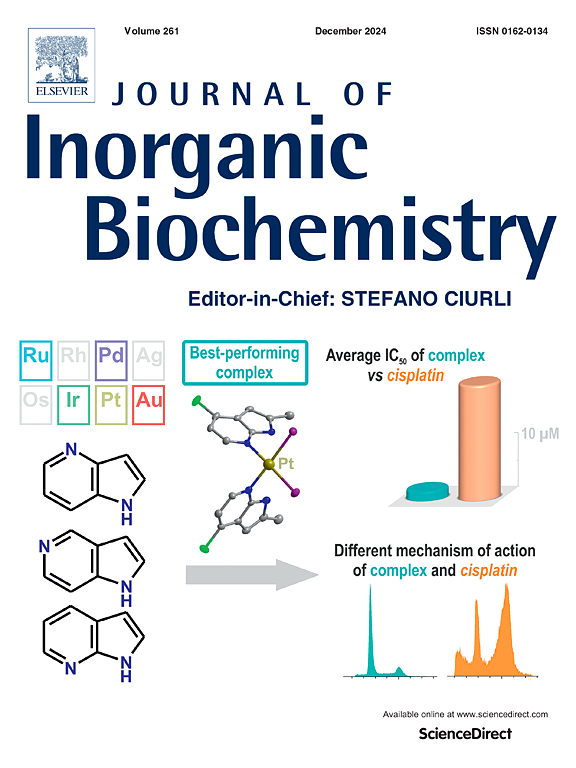Antitumor activity of ruthenium(III) complexes with [N2O2]-tetradentate Schiff base ligands
IF 3.2
2区 化学
Q2 BIOCHEMISTRY & MOLECULAR BIOLOGY
引用次数: 0
Abstract
In this article, the antitumor and antiproliferative activity of three Ru(III) complexes, [RuIII(Salen)(PPh3)Cl] (RuSalen), [RuIII(Salphen)(PPh3)Cl] (RuSalphen), and [RuIII(Salpn)(PPh3)Cl] (RuSalpn) (H2Salen, H2Salphen and H2Salpn are the Schiff bases obtained by the condensation between salicylaldehyde and ethylenediamine, 1,2-phenylenediamine, and 1,3-diaminopropanne, respectively) and their precursor, [RuII(PPh3)3Cl2], were investigated against laboratory-cultured tumor cell lines: HT29 (human colorectal carcinoma), Saos-2 (human osteogenic sarcoma), HeLa (human cervical carcinoma), RST (rat transplantable sarcoma), and the non-tumor cell line Lep3 (embryonal human fibroblasts). It was found that all the cancer cell lines investigated were effectively dose-dependently inhibited in their growth by the Ru(III) complexes, while the non-tumor cell line Lep3 was the least affected by their cytotoxic effect. The Annexin V assay revealed that the Ru(III) complexes determined the occurrence of apoptosis in all cell lines tested, in a dose-dependent manner. RuSalpn exhibited the strongest ability to reduce tumor cell survival and proliferation, with efficacy that is either superior to or comparable to that of well-established clinical oncology agents such as cisplatin, oxaliplatin, epirubicin, and paclitaxel. The experiments revealed a cell-specific response, with varying degrees of sensitivity to the tested substances across different cell lines. RuSalpn demonstrated the strongest cytotoxic effect in the HT29 cell line, while RuSalen, RuSalphen showed the highest activity against RST cells. It was found that RuSalphen (≥7.0 μM) significantly inhibited cell migratory activity in the HT29 cell line, while in the RST cell line, RuSalen (≥37.6 μM), RuSalphen (≥14.0 μM), and RuSalpn (≥36.8 μM) demonstrated a strong inhibitory effect on cell migration.

[N2O2]-四齿席夫碱配合物钌(III)的抗肿瘤活性
本文研究了[RuIII(Salen)(PPh3)Cl] (RuSalen)、[RuIII(Salphen)(PPh3)Cl] (RuSalphen)、[RuIII(Salpn)(PPh3)Cl] (RuSalphen)和[RuIII(Salpn)(PPh3)Cl] (RuSalpn) (H2Salen、H2Salphen和H2Salpn分别是水杨醛与乙二胺、1,2-苯二胺和1,3-二氨基丙烷缩合得到的希夫碱)及其前体[RuII(PPh3)3Cl2])对实验室培养肿瘤细胞系的抗肿瘤和抗增殖活性。HT29(人结直肠癌)、Saos-2(人成骨肉瘤)、HeLa(人宫颈癌)、RST(大鼠可移植肉瘤)和非肿瘤细胞系Lep3(胚胎性人成纤维细胞)。研究发现,Ru(III)复合物对所有肿瘤细胞系的生长均有剂量依赖性的抑制作用,而对非肿瘤细胞系Lep3的细胞毒作用影响最小。Annexin V实验显示Ru(III)复合物以剂量依赖的方式决定了所有细胞系的凋亡发生。RuSalpn显示出最强的降低肿瘤细胞存活和增殖的能力,其疗效优于或可与临床公认的肿瘤药物如顺铂、奥沙利铂、表柔比星和紫杉醇媲美。实验揭示了一种细胞特异性反应,不同细胞系对测试物质的敏感性不同。RuSalpn对HT29细胞系的细胞毒作用最强,而RuSalen、RuSalphen对RST细胞的细胞毒作用最强。结果发现,在HT29细胞系中,RuSalphen(≥7.0 μM)显著抑制细胞迁移活性,而在RST细胞系中,RuSalen(≥37.6 μM)、RuSalphen(≥14.0 μM)和RuSalpn(≥36.8 μM)对细胞迁移有较强的抑制作用。
本文章由计算机程序翻译,如有差异,请以英文原文为准。
求助全文
约1分钟内获得全文
求助全文
来源期刊

Journal of Inorganic Biochemistry
生物-生化与分子生物学
CiteScore
7.00
自引率
10.30%
发文量
336
审稿时长
41 days
期刊介绍:
The Journal of Inorganic Biochemistry is an established international forum for research in all aspects of Biological Inorganic Chemistry. Original papers of a high scientific level are published in the form of Articles (full length papers), Short Communications, Focused Reviews and Bioinorganic Methods. Topics include: the chemistry, structure and function of metalloenzymes; the interaction of inorganic ions and molecules with proteins and nucleic acids; the synthesis and properties of coordination complexes of biological interest including both structural and functional model systems; the function of metal- containing systems in the regulation of gene expression; the role of metals in medicine; the application of spectroscopic methods to determine the structure of metallobiomolecules; the preparation and characterization of metal-based biomaterials; and related systems. The emphasis of the Journal is on the structure and mechanism of action of metallobiomolecules.
 求助内容:
求助内容: 应助结果提醒方式:
应助结果提醒方式:


